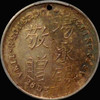PCGS AU55 秘鲁洪门(天地会)汤永锡 71大寿纪念章
中国洪门民治党驻利马总支部 (秘鲁洪门民治党)
中文名: 中国洪门民治党驻利马总支部
人员: 秘鲁利马华侨
贡献: 对辛亥革命,中国抗日战
1946年又改为中国洪门民治党驻利马总支部。与1950年设在加拿大温哥华的中国洪门民治党总部仅靠书信联络,实际上利马总支部独树一帜。40-50年代为鼎盛时期,除利马外,在秘鲁北部、南部及亚马逊地区多埠,均设有分部,洪门人士达数千人之众。当时利马总支部著名党员有: 汤永锡、罗联伟、三多、吕彩良、古容等30多人。1966年举行第33届全秘洪门恳亲大会,主席为黄金华。1971年中秘鲁交后,该总支部动员党参加促进中秘友好的社会活动。90年代以来,活动较少,党员仅有百余人。历史上,秘鲁洪门人士对辛亥革命、中国抗日战争均有较大贡献。80年代末主席陈士佑,盟长应华荃,元老古容。1986年主席唐庄生。
洪门1674年起源雏形能够延序至今三百四十五年的历史,与其自身的传承和民族复兴的历史使命分不开。在秘鲁洪门的存在与华人大规模移民秘鲁同期,秘鲁洪门在鼎盛时期有3000成员,在秘鲁沿海各地均有分支机构。有历史资料证明,秘鲁洪门组织参与了中华通惠总局的前期筹建工作。
洪門,又稱天地會,与袍哥会、青帮为清朝三大秘密结社,主要活动于華南,以福建、广东、湖廣等地區更盛。有時史學家所謂的洪门一詞,代表一切反清的祕密會社,如青幫、理教等。後來演變成名称不一的多個地下社團或會黨,並隨著華僑移民南洋而傳播東南亞。
1840年代鴉片戰爭後,廣東幫會會眾借洪門之名反對地方政府。原本就是互不統屬、各有不同宗旨的社團,因為同一理由互相合作,對外宣傳,吸引新會眾,實屬发动民变的社團組織,如像歷史上白蓮教所发动民間組織的社團民变一樣。洪门也協助太平天国,幼天王洪天贵福逃亡途中的护军就是广东洪门。
清末時,革命黨為了推翻滿清需要而參與洪門;及至1911年中華民國肇建後,不少天地會、三合會成員均有國民革命軍身份。1949年後,香港三合會組織的兩大龍頭大佬皆有中華民國國軍將領軍階。
China Hongmen Democratic Party General Branch in Lima (Peru Hongmen Democratic Party)
Chinese name: China Hongmen Democratic Party General Branch in Lima
Personnel: Overseas Chinese in Lima, Peru
Contributions: To the Revolution of 1911, China's Anti-Japanese War
In 1946, it was changed to the general branch of the Chinese Hongmen Democratic Party in Lima. It only communicated with the headquarters of the Hongmen Democratic Party of China, which was established in Vancouver, Canada in 1950. In fact, the Lima branch was unique. The 1940s and 1950s were the heyday. Except for Lima, there were branches in many ports in the northern and southern parts of Peru and the Amazon region, with thousands of Hongmen people. At that time, there were more than 30 famous party members in the Lima branch: Tang Yongxi, Luo Lianwei, Sanduo, Lv Cailiang, Gu Rong, etc. In 1966, the 33rd All-Secretary Hongmen Family Meeting was held, and the chairman was Jinhua. After Sino-Peru handover in 1971, the branch mobilized the party to participate in social activities to promote Sino-Peru friendship. Since the 1990s, there have been few activities, with only a hundred party members. Historically, people from the Hongmen in Peru made great contributions to the Revolution of 1911 and the War of Resistance Against Japanese Aggression in China. In the late 1980s, the chairman Chen Shiyou, the leader Ying Huaquan, and the elder Gu Rong. 1986 Chairman Tang Zhuangsheng.
The rudimentary origin of Hongmen in 1674 can be extended to the history of 345 years, which is inseparable from its own inheritance and the historical mission of national rejuvenation. The existence of Hongmen in Peru coincided with the mass immigration of Chinese to Peru. The Hongmen of Peru had 3,000 members in its heyday and had branches all over the coast of Peru. Historical data proves that the Peruvian Hongmen Organization participated in the preparatory work of the China General Administration of Tonghui.
Hongmen, also known as Tiandihui, together with Paogehui and Qinggang, were the three secret associations in the Qing Dynasty, and their main activities were in southern China, especially in Fujian, Guangdong, Huguang and other regions. Sometimes the so-called Hongmen by historians refers to all the secret societies that oppose the Qing Dynasty, such as the Youth Gang, Lijiao, etc. Later, it evolved into multiple underground societies or clubs with different names, and spread to Southeast Asia as overseas Chinese immigrated to Nanyang.
After the Opium War in the 1840s, Cantonese gang members opposed the local government in the name of Hongmen. Originally, it was an association that did not belong to each other and had different purposes. For the same reason, they cooperated with each other, publicized and attracted new congregations. It was an association that launched a civil revolution, just like the civil society organized by the White Lotus Sect in history. . Hongmen also assisted the Taiping Heavenly Kingdom. The guardian of the young king Hongtian Guifu on his escape was Hongmen of Guangdong.
At the end of the Qing Dynasty, the revolutionary party participated in the Hongmen in order to overthrow the Manchu Qing; and after the founding of the Republic of China in 1911, many members of the Tiandihui and triads had the identity of the National Revolutionary Army. After 1949, the two leading leaders of the Hong Kong triad organization were both generals in the National Army of the Republic of China.










